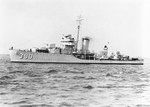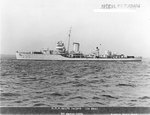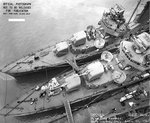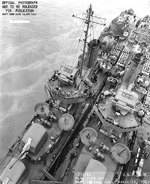Ralph Talbot
| Country | United States |
| Ship Class | Bagley-class Destroyer |
| Hull Number | DD-390 |
| Builder | Boston Navy Yard |
| Laid Down | 28 Oct 1935 |
| Launched | 31 Oct 1936 |
| Commissioned | 14 Oct 1937 |
| Decommissioned | 29 Aug 1946 |
| Sunk | 8 Mar 1948 |
| Displacement | 2,325 tons standard |
| Length | 341 feet |
| Beam | 36 feet |
| Draft | 13 feet |
| Machinery | General Electric geared turbines, 2 screws |
| Power Output | 49,000 shaft horsepower |
| Speed | 35 knots |
| Range | 6,500nm at 12 knots |
| Armament | 4x5in, 4x0.50cal machine guns, 3x4x21in torpedoes |
Contributor: C. Peter Chen
ww2dbaseNamed after WW1-era United States Marine Second Lieutenant Ralph Talbot, the destroyer was sponsored by Mrs. Mary Talbot, Ralph's mother in 1936 and commissioned to Lieutenant Commander H. R. Thurber in 1937. Destroyer Ralph Talbot was a part of the Destroyers, Battle Force of the United States Navy and operated off the west coast of the United States. In Apr 1941, she entered Mare Island Navy Yard in California, United States, and served the remainder of her pre-war career at Pearl Harbor.
ww2dbaseAt the date of the Japanese attack on Pearl Harbor in Dec 1941, Ralph Talbot was moored there. Her anti-aircraft guns were firing at the Japanese aircraft within minutes of the start of the attack, and by 0900 that morning she had downed one aircraft. After the attack, she patrolled for Japanese aircraft. On 14 Dec, she sortied with Task Force 14 as escort for the Task Force's carriers. In Jan and Feb 1942, with Task Force 8, she supported carriers as they launched their aircraft against Japanese positions in the Marshall and Gilbert Islands; in Mar, she performed a similar role during attacks on Wake and Marcus Islands. On 9 Mar 1942, she returned to Pearl Harbor. Between Mar and May 1942, she performed convoy duties between Pearl Harbor and the west coast of the United States. After the Battle of Midway, she escorted auxiliary vessels to Midway area to replenish ships that participated in the battle, then escorted Task Force 16 to Pearl Harbor. On 14 Jun, she sailed for Australia and New Zealand.
ww2dbaseOn 22 Jul, Ralph Talbot sailed for the Solomon Islands. On 7 Aug, she arrived off Guadalcanal in support of Task Group 62.6 during the landings. Beginning on 8 Aug, she patrolled north of Savo Island. At 0145 on 9 Aug, she received word of three Japanese ships; soon afterwards, she observed gunfire to the southwest, which was the start of the Battle of Savo Island. As she approached the battle, she was shelled by a friendly destroyer at about 0215. A few minutes later, a Japanese cruiser lit Ralph Talbot brightly with spotlight and fired at her. A shell landed at the chart house, destroying radar equipment and fire control circuits. Three more shells came down in close succession, hitting the wardroom, the starboard quarter, and the underside of gun number 4. Eleven members of her crew were killed, including the ship's doctor and the chief pharmacist's mate. At 0221, Ralph Talbot ceased firing after the Japanese fleet left in fear of an American air attack after dawn, but the battle continued for her as the damage control team fought the intense fire that enveloped the bridge. Meanwhile, the ship listed heavily to starboard. At 0230, all radio communication to and from the vessel stopped. By 0330, the fire was contained and the flooding was stopped. Soon after 0700, communication was re-established, and by 1210 enough temporary repairs were done for her to get underway. She arrived at Mare Island Navy Yard on 11 Sep 1942 to receive permanent repairs.
ww2dbaseOn 11 Nov 1942, Ralph Talbot steamed out of Mare Island Navy Yard for Hawaii. On 16 Dec, she departed for Australia. She remained in Brisbane for training and convoy duties between 2 Jan and 10 May 1943. Between 13 May and mid-Jun, she performed training and convoy duties out of Nouméa, New Caledonia. On 30 Jun, she covered the landings on Rendova Island, New Georgia, Solomon Islands, rescuing 300 survivors of APA McCawley on that day. On 5 Jul, she bombarded Rice Anchorage in New Georgia with her 5-inch guns, following by landing men of the 148th Infantry there. On 9 and 11 Jul, she bombarded Munda in southwestern New Georgia. During the night of 12 to 13 Jul 1943, she participated in the Battle of Kolombangara; at the end of that action, her torpedoes scuttled destroyer Gwin. From Aug through Oct, she remained in the Solomon Islands area, performing patrol and escort duties. On 27 Oct, she left for Australia. On 3 Nov, she arrived at Milne Bay, New Guinea, where she resumed patrol and escort duties. During the night of 29 Nov, with Task Force 74, she bombarded Japanese positions on New Britain. In mid-Dec, she covered the landings on Kiriwina Island, Trobriand Islands, off New Guinea. In late-Dec, she covered the landings on Cape Gloucester, New Britain. On 1 Jan 1943, she sailed with Task Force 76 and conducted pre-landing bombardment of Saidor, New Guinea. She left the New Guinea area in early Feb 1943 for overhaul in the United States.
ww2dbaseAfter a brief stay at Pearl Harbor in May 1944, Ralph Talbot returned to the South Pacific. She escorted a convoy between Eniwetok, Marshall Islands to Saipan, Mariana Islands, arriving at Garapan Harbor on 5 Jul, then provided gunfire support for ground troops. After evacuating casualties, she provided gunfire support at Tinian on 27 Jul. She escorted ships through most of Aug 1944, then joined Task Force 38.4 in support of the attack against the Volcano and Bonin Islands between 31 Aug and 2 Sep, Yap on 7 and 8 Sep, and the Palau Islands between 10 and 19 Sep. In Oct, she patrolled for Japanese shipping in the general area enclosed by Okinawa, Taiwan, and Luzon of the Philippine Islands. On 20 Oct, she supported Leyte landings in the Philippine Islands. On 25 Oct, she screened carriers and battleships during the Battle off Cape Engaño. After patrolling the Leyte Gulf area between 16 and 27 Nov, she escorted escort carriers into the Sulu Sea to support the Mindoro landings and then the Luzon landings between 1 and 17 Jan 1945. She screened transports bound for Iwo Jima in Feb 1945, and remained in the area on patrol until 27 Feb. She replenished at Ulithi between 5 Mar and 20 Apr.
ww2dbaseOn 26 Apr, Ralph Talbot arrived at Okinawa, where the battle had already been waging for almost a month. As a part of Task Group 51.5, she performed anti-aircraft screen duties. At 2200 on 27 Apr, she was struck on the starboard side aft by a special attack fighter, while a second missed, splashing into the sea off the port quarter. She sailed to Kerama Retto nearby for temporary repairs, returning to service on 20 May. She performed convoy duties between the Mariana Islands and the Ryuku Islands for the remainder of the Pacific War. In Aug, she rescued 24 survivors of the cruiser Indianapolis.
ww2dbaseOn 1 Sep 1945, Ralph Talbot escorted heavy cruiser Portland from Guam to Truk and stood by the next day during the Truk surrender ceremony aboard Portland. She operated off southern Japan in Oct and returned to the United States on 29 Oct. She was used as a target ship during the Operation Crossroads atomic bomb tests at Bikini Atoll in the Marshall Islands in Jul and Aug 1946. Contaminated with radiation, she was sunk off Kwajalein in Mar 1948.
ww2dbaseSource: United States Navy Dictionary of American Naval Fighting Ships.
Last Major Revision: Jun 2007
Destroyer Ralph Talbot (DD-390) Interactive Map
Photographs
 |  |  |  |
Ralph Talbot Operational Timeline
| 28 Oct 1935 | Gridley-class destroyer Ralph Talbot was laid down at the Boston Navy Yard, Massachusetts, United States |
| 31 Oct 1936 | Destroyer Ralph Talbot was launched at the Boston Navy Yard, Massachusetts, United States. Ship's sponsor was Mrs. Mary Talbot, mother of Marine 2nd Lt Ralph Talbot, killed in World War I and after whom the ship was named. |
| 14 Oct 1937 | Ralph Talbot was commissioned into service at the Boston Navy Yard, Massachusetts, United States with Lt. Cmdr. Harry R. Thurber in command. |
| 18 Jun 1942 | Destroyers USS Castor, Ralph Talbot, and Blue crossed the equator bound from Pearl Harbor, Hawaii to Pago Pago, Samoa. |
| 1 Jul 1942 | Destroyers USS Castor, Ralph Talbot, and Blue crossed the 180th Meridian bound from Pago Pago, Samoa to Auckland, New Zealand. |
| 9 Jul 1942 | Destroyers USS Castor, Ralph Talbot, and Blue arrived at Sydney, Australia. |
| 11 Jul 1942 | Destroyers USS Castor, Ralph Talbot, and Blue shifted to Brisbane, Australia. |
| 28 Jul 1942 | US Navy and Marines began a four-day amphibious landing exercise at Fiji as rehearsals for the Guadalcanal landings set for two weeks later. |
| 9 Aug 1942 | Northwest of Savo Island in the Solomons, destroyer USS Ralph Talbot was fired upon by a friendly ship shortly after midnight. Two men were killed. Minutes later, Ralph Talbot exchanged gunfire with Japanese cruiser Furutaka that killed ten men aboard Ralph Talbot, wounded 23, and left two men missing. |
| 11 Sep 1942 | Destroyer USS Ralph Talbot arrived at Mare Island Naval Shipyard for repairs to battle damage. |
| 16 Dec 1942 | Cruiser USS Nashville and destroyer Ralph Talbot departed Pearl Harbor, Hawaii bound for Nouméa, New Caledonia escorting United States Army Transport Frederick Funston. |
| 20 Dec 1942 | USS Nashville crossed the equator for the first time and escort USS Ralph Talbot crossed for the second time heading from north to south while escorting USAT Funston from Pearl Harbor, Hawaii to Viti Levu in the Fiji Islands. |
| 30 Jun 1943 | While covering the landings on Rendova, Solomon Islands, destroyer USS Ralph Talbot engaged attacking Japanese Mitsubishi G3M 'Nell' bombers armed with torpedoes. Firing 5-inch shells fitted with VT proximity fuzes from her 5-inch/38 caliber guns, Ralph Talbot accounted for three bombers shot down on her own and one more shared with other ships. During the attack, one torpedo struck attack transport USS McCawley causing her to go dead in the water. Ralph Talbot came alongside and took aboard 300 McCawley officers and men. Three hours later, McCawley was sunk by torpedoes from US PT Boats. |
| 13 Jul 1943 | Shortly after midnight, cruisers USS Honolulu, USS St. Louis, and HMNZS Leander escorted by destroyers USS Nicholas, USS O'Bannon, USS Radford, USS Jenkins, USS Chevalier, USS Gwin, USS Woodworth, USS Buchanan, and USS Maury engaged Japanese cruiser Jintsu and destroyers Yukikaze, Hamakaze, Yugure, Mikazuki, and Kiyonami in New Georgia Sound north of Kolombangara. Japanese Type 93 torpedoes damaged Honolulu, St. Louis, and Leander. Destroyers Woodworth and Buchanan were damaged in a collision. Jintsu was sunk by cruiser gunfire and a torpedo. Destroyer Yukikaze was damaged. Destroyer USS Ralph Talbot went to the aid of USS Gwin, badly damaged by a torpedo, and took aboard 155 officers and men. USS Maury took another 53 officers and men. Ralph Talbot then scuttled Gwin with torpedoes. The Japanese were able to land 1,200 men nevertheless. |
| 30 Nov 1943 | Shortly after midnight, US destroyers USS Ralph Talbot & Helm along with Australian destroyers HMAS Arunta & Warramunga shelled the Ring Ring Plantation area of Gasmata, New Britain with the aid of flares dropped by PBY Catalina "Black Cat" aircraft.. |
| 26 Dec 1943 | The Allied assault on New Britain expanded with US 1st Marine Division landing near Cape Gloucester. |
| 27 Feb 1944 | USS Ralph Talbot arrived Hunters Point Naval Shipyard for an overhaul that last two months and was immediately followed by three weeks of emergency repairs at Pearl Harbor, Hawaii. |
| 14 Jun 1944 | USS Ralph Talbot departed Pearl Harbor, Hawaii as part of a convoy screening unit that ultimately arrived at Saipan, Mariana Islands. |
| 28 Aug 1944 | After eight weeks of escort duty, destroyer USS Ralph Talbot was assigned to Task Force 38 Fast Carrier Force as a screening vessel for carriers USS Enterprise, Franklin, and San Jacinto then at Eniwetok, Marshall Islands. |
| 31 Aug 1944 | USS Franklin launched strikes against Iwo Jima and Chichi Jima through 2 Sep 1944. |
| 13 Feb 1945 | Destroyer escort USS Tabberer arrived off Saipan, Mariana Islands and delivered a supply convoy. Tabberer then sailed with escort carrier USS Anzio and destroyer USS Ralph Talbot for Iwo Jima. |
| 27 Apr 1945 | Northwest of Okinawa, destroyer USS Ralph Talbot was struck by a special attack aircraft and nearly struck by another. The result was five men killed, many more wounded, and moderate damage to the ship. |
| 2 Sep 1945 | At Truk Atoll, Caroline Islands, USS Portland (with USS Ralph Talbot as escort) received aboard Lieutenant General Shunzaburo Magikura of the Japanese Imperial Army, Vice Admiral Chuichi Hara of the Japanese Imperial Navy, Rear Admiral Aritaka Aihara of the Japanese Imperial Navy and head of the Eastern Branch of the Japanese South Seas Government and their aides. Together, they surrendered all islands and territories under their commands to Vice Admiral George Murray, acting on behalf of Fleet Admiral Chester Nimitz. Immediately following the signing of the surrender documents, Portland departed Truk bound for Guam. |
| 29 Aug 1946 | Ralph Talbot was decommissioned from service. |
Did you enjoy this article or find this article helpful? If so, please consider supporting us on Patreon. Even $1 per month will go a long way! Thank you. Share this article with your friends: Stay updated with WW2DB: |
Visitor Submitted Comments
30 Aug 2012 12:58:31 PM
Charles Marino was 1c, he was killed on the USS Ralph Talbot in WWII, as my brother asked, if anyone has any information on our uncle we would greatly appreciate it
27 May 2013 01:58:59 PM
A very nice site, I have been reading that there where 2 sailors with the name Aupperlee John and William on this ship during the war , my Question is,, are they brothers ? and do they or their ancestors come from The Netherlands.thanks greetings from Holland.
23 Jun 2013 03:13:10 PM
John and Bill Auperlee were a song and dance duo before and during the war, performing on the USS Arizona 1 week before Dec 7. John passed away and I am not sure about Bill, who retired and has been reunion contact, in North Hollywood, CA. His phone is listed. My grandfather was a close friend of both - George Carl McCarter.
28 Aug 2013 02:18:21 PM
My Daddy was a F2 on the Talbot .His name is Irving M. Davies and he was in the boiler room of the ship when it was hit...he survived the battle,but told us very little of his experience...Does anyone remember this or my Daddy?? Any info would be gratefully appreciated. Thank You All for your service...
21 Sep 2013 02:26:19 PM
I am at a Ralph Talbot reunion as I write this. John and Bill Aupperlee were indeed brothers -- twin brothers. Both have now passed away. I mentioned Charles Marino, and the 2 crew members here think there is some info in the Ralph Talbot book we have. RT took casualities when a kamikaze hit, and in a couple of other actions. Do you know when he died?
31 Dec 2013 10:37:24 PM
My uncle was also one of those wounded by the kamikaze attack on April 27, 1945.
25 May 2015 06:08:05 AM
Today is Memorial day and I am thinking of my Uncle Charlie today. I have the USS Ralph Talbot book and it tells the story of the kamikaze hit and the men who died, one being my Uncle. God Bless him and all of the men who gave the ultimate sacrifice for this beautiful country.
28 Jul 2015 12:03:50 PM
My uncle Gordon Burke was on the Rat-Trap as she was affectionately called. I remember all his stories from the time in the Solomon Islands to the kamikaze hit. I love those stories and I miss my Uncle.
12 Aug 2015 09:42:43 AM
Bill Aupperlee was my dad. I grew up listening to endless war stories. It was great. My dad and uncle Jack were stationed in the engine room. What a great generation, I was fortunate to be given dozens of video tapes and cassettes of many of there reunions. If anyone is interested I'm sure copies can be made.
Jacki Aupperlee Mitchell
30 Jul 2017 08:12:52 PM
My grandfather, Richard Junior Spencer, served on this ship, and I'm told that his father, Richard Dale Spencer, also served on it before him. I'd like to find more info about his father if possible. Many comments on this page have mentioned the kamikaze attack. My grandmother told me that her husband held bitter contempt for the Japanese the rest of his life after being tasked to fish the bodies of his fallen comrades from the sea after that attack.
24 Jun 2018 03:42:32 PM
I just found out today that my wife's uncle, SA or S2C Robert "Dee" Florentine Bludworth from Mississippi was one of the 12 men killed at Savo Island. We thought he was on the USS Quincy (CA-39) so any help or info if he was on the DD-390 would be greatly appreciated. Help an old retired Senior Chief because we would eventually like to get him a marker for the family plot.
23 Oct 2018 12:20:55 PM
My dad,Glenn Eastman Ward, was on the Talbot,7 Dec 1941.He passed many years ago,but told me they had steam up,and were leaving that Sun. morning.What a story !
4 Apr 2020 10:26:55 PM
My grandfather, Irving Davies, served on this ship, and I would love to connect with relatives of other men who served with him.
8 Jul 2020 03:00:36 PM
My Grandfather, Edward Benedict Blue was a Pharmacist's Mate on the Talbot, and was a boxer during the war. He died before I was born.
4 Jul 2021 01:47:04 PM
My grandfathers served on DD390 from Pearl Harbor to Japanese surrender and participated in all the major battles of the Pacific. Savo Island, Marshals Islands, Guadal Canal, Iwo Jima etc. His name was Paul Stroud. He passed at age 96 in 2020. USS Ralph Talbot was one of the most decorated Destroyers in WW2 waning 14 battle stars.
15 Aug 2021 03:43:06 PM
My Grandfather James C MacLennan served on the Talbot from just before Pearl Harbor to past the surrender of Japan I believe to after the war. I remember he and my Grandma going to the ship reunions on a regular basis. To Jessica Garland and others who may want to connect please email me at tentoomany5@att.net. Thanks
All visitor submitted comments are opinions of those making the submissions and do not reflect views of WW2DB.
» Attack on Pearl Harbor
» Guadalcanal Campaign
» Solomon Islands Campaign
» New Guinea-Papua Campaign, Phase 3
» Mariana Islands Campaign and the Great Turkey Shoot
» Palau Islands and Ulithi Islands Campaigns
» Philippines Campaign, Phase 1, the Leyte Campaign
» Philippines Campaign, Phase 2
» Battle of Iwo Jima
» Okinawa Campaign
» Japan's Surrender
Document(s):
» US Navy Report of Japanese Raid on Pearl Harbor, Enclosure E, USS Ralph Talbot
 |
- » 1,150 biographies
- » 337 events
- » 43,917 timeline entries
- » 1,241 ships
- » 350 aircraft models
- » 207 vehicle models
- » 375 weapon models
- » 123 historical documents
- » 260 facilities
- » 470 book reviews
- » 28,549 photos
- » 432 maps
Winston Churchill
Please consider supporting us on Patreon. Even $1 a month will go a long way. Thank you!
Or, please support us by purchasing some WW2DB merchandise at TeeSpring, Thank you!
7 Mar 2010 09:02:34 AM
My Uncle was killed on the USS Ralph Talbot. His name was Charles Marino. Does anyone have any pictures of him or any other information.